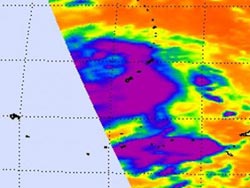NASA satellite sees Tropical Storm Sanvu pass Guam, strengthen

This infrared image of Tropical Storm Sanvu was captured from the AIRS instrument on NASA's Aqua satellite on May 22, and shows a large area of very strong thunderstorms near the center of circulation. The purple color indicates the coldest cloud top temperatures, and strongest thunderstorms with the heaviest rainfall.<br><br>Credit: Credit: NASA JPL, Ed Olsen<br>
On May 22 at 0900 UTC (5 a.m. EDT), Tropical Storm Sanvu was more than 100 miles west-northwest of Andersen Air Force Base, Guam, and still over 600 nautical miles south of Iwo To, Japan and headed in that direction.
Sanvu's center was located near 15.2 North and 141.9. East. It was still churning up rough surf around Guam. Sanvu has maximum sustained winds near 45 knots (52 mph/83 kph) with higher gusts. Sanvu is a compact tropical storm, with tropical-storm-force winds extending out 90 miles from the center, making it about 180 miles in diameter.
An infrared image of Tropical Storm Sanvu was captured from the Atmospheric Infrared Sounder (AIRS) instrument onboard NASA's Aqua satellite on May 22, and shows a large area of very strong thunderstorms near the center of circulation.
Forecasters at the Joint Typhoon Warning Center noted the AIRS imagery “shows the system has further consolidated and convection has resurged, especially along the northeast flank.”
Forecasters expect Sanvu to keep intensifying as it moves closer to Iwo To because of warm sea surface temperatures and light wind shear. Thereafter it is expected to curve to the northeast and transition to an extra-tropical storm.
Media Contact
More Information:
http://www.nasa.govAll latest news from the category: Earth Sciences
Earth Sciences (also referred to as Geosciences), which deals with basic issues surrounding our planet, plays a vital role in the area of energy and raw materials supply.
Earth Sciences comprises subjects such as geology, geography, geological informatics, paleontology, mineralogy, petrography, crystallography, geophysics, geodesy, glaciology, cartography, photogrammetry, meteorology and seismology, early-warning systems, earthquake research and polar research.
Newest articles

High-energy-density aqueous battery based on halogen multi-electron transfer
Traditional non-aqueous lithium-ion batteries have a high energy density, but their safety is compromised due to the flammable organic electrolytes they utilize. Aqueous batteries use water as the solvent for…

First-ever combined heart pump and pig kidney transplant
…gives new hope to patient with terminal illness. Surgeons at NYU Langone Health performed the first-ever combined mechanical heart pump and gene-edited pig kidney transplant surgery in a 54-year-old woman…

Biophysics: Testing how well biomarkers work
LMU researchers have developed a method to determine how reliably target proteins can be labeled using super-resolution fluorescence microscopy. Modern microscopy techniques make it possible to examine the inner workings…





















